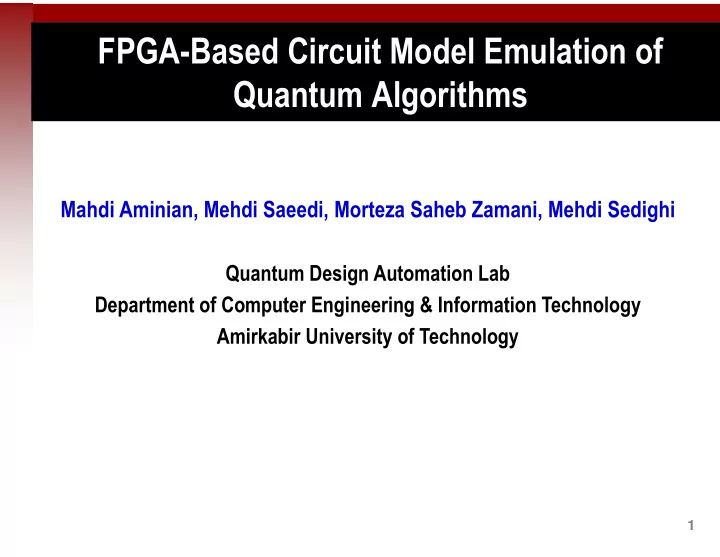

FPGA-Based Circuit Model Emulation of Quantum Algorithms Mahdi Aminian, Mehdi Saeedi, Morteza Saheb Zamani, Mehdi Sedighi Quantum Design Automation Lab Department of Computer Engineering & Information Technology Amirkabir University of Technology 1
Outline Background Motivation Quantum Gates Emulation Method Experimental Results Conclusion 2
Background State of qubit represent as | ψ = α |0 + β |1 (superposition state) ‘ α ’ and ‘ β ’ are complex numbers and || α || 2 + || β || 2 =1 Not possible to find the exact value of an unknown qubit using a measurement operator Upon measurement its state collapses to |0 or |1 with the probability of || α || 2 and || β || 2 A quantum system of size N can be constructed using the tensor product The property of working on multiple input states simultaneously leads to a significant parallelism in quantum algorithms 3
Motivation Several problems that cannot be executed on a classical machine as efficiently as a quantum computer Due to the lack of an existing quantum computer, simulating quantum algorithms on a classical computer is widely used Using simulation to verify the functionalities of quantum algorithms software simulation cannot profit the intrinsic parallelism of quantum algorithms completely using the parallel nature of hardware architectures 4
Quantum Gates 0 1 0 1 X 0 1 i 0 i 1 Y 0 1 0 1 Z 0 1 H 0 1 2 2 i 0 1 PS 0 e 1 5
Quantum Gates (cont.) 0 1 1 1 00 01 11 10 1 2 1 2 1 2 1 2 0 1 2 2 j 2 / 2 i 0 1 Rj 0 e 1 0 1 1 1 2 i j 00 01 2 ( 10 11 ) e 1 2 1 2 1 2 1 2 0 1 Rj 2 2 6
Emulation Method Fixed-point numbers for represent complex coefficients of each qubit each qubit can be represented by four fixed-point numbers 7
Emulation Method (cont.) Two group of gates HRC group Hadamard gate (H) Phase-Shift gate (PS) Rotate gate (R) Controlled-Rotate gate (CR) XYZC group X gate (NOT) Y gate Z gate Controlled-NOT gate (CNOT) 8
Emulation of HRC group H gate needs four multiplications and four additions on fixed-point numbers PS and R gates needs four multiplications and two additions CR gate rotating the target qubit if the control line is equal to 1 CR gate produces an entanglement state In entanglement state, more resources are needed for simulating 9
Emulation of XYZC group Using three extra bits added to each qubit coefficient The X, Y, Z gates are efficiently manipulated as below 10
Emulation of XYZC group (cont.) In entangled state, more extra bits added to each coefficient ‘ n ’ is the number of qubits CNOT gate is implemented by XORing the control and target bits 11
Emulation of XYZC group (cont.) When both XYZC and HRC gates are used, method is changed gate operations are implemented by a coefficient swapping operator using intermediate registers as below: X gate swaps the complex coefficients Y gate swaps coefficients and multiplying the complex number i (or –i) Z gate implemented by multiplying -1 to the complex coefficient β CNOT gate swaps appreciate coefficients in entangled state 12
Results: Implementation of each gate Implementation with VHDL Using ALTERA STRATIX EP1S80B956C6 device for synthesis 13
Results: Quantum Fourier Transform (QFT) QFT circuit synthesis results and run time for a 3-input QFT algorithm 14
Results: Implementation of Benchmark Specification of benchmarks 15
Results: Implementation of Benchmark (cont.) LC usage for synthesis of benchmarks 16
Conclusion Proposed an efficient quantum circuit emulation technique This method uses the parallelism of quantum algorithms Offers more efficiency than software simulation uses fewer logic cells compared with the available hardware emulation methods Using a novel representation schema Emulating the behaviors of various quantum gates 17
Questions? 18
Recommend
More recommend